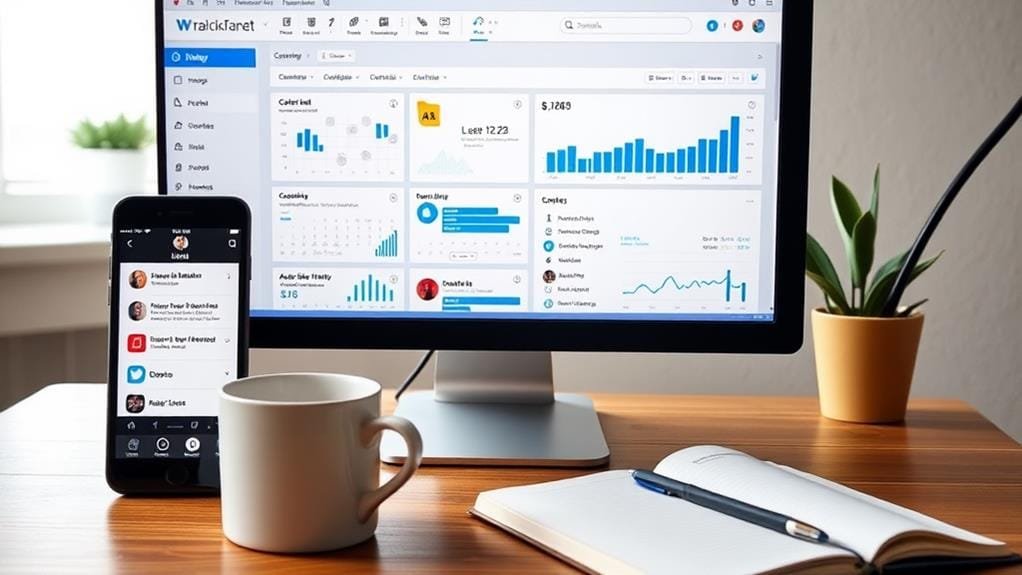Social media marketing tips and tricks help businesses connect with customers online. It uses platforms like Facebook and Instagram to share information about products and services. To do well, companies need to pick the right social networks for their audience.
They should post interesting content regularly and talk with followers. Good photos and videos are significant to catch people’s attention. Using tools can help manage multiple accounts easily. It’s essential to track how well posts are doing and make changes if needed. Learning the best tips for social media marketing tips takes time, but it can really enhance a business. The rest of this guide offers more detailed tips for success. 7 Elite Steps Boost Business Social Media
Key Points
- Choose the right platforms based on your target audience and industry relevance.
- Create engaging, platform-specific content that aligns with your brand identity and values.
- Develop a consistent posting schedule and use analytics tools to refine your strategy.
- Engage actively with your audience through comments, messages, and trending conversations.
- Integrate various content types (images, videos, stories) to maintain audience interest and boost engagement.
Introduction to Social Media Marketing TIPS

Social media marketing tips say when businesses use sites like Facebook and Instagram to tell people about their products.
It helps companies talk to customers and make new friends who might buy things.
Good social media marketing tips can make a business more popular and sell more products, but it takes time to learn how to do it well.
What is Social Media Marketing?
In the technological age, social media marketing tips are indispensable tools for businesses seeking to connect with their target audience.
The best social media marketing tips is when companies use websites like Facebook, Instagram, and Twitter to talk to people who might buy their stuff. It’s about making fun and interesting posts that people want to see and share with their friends.
Companies use social media to tell people about their products, answer questions, and make new friends who like their brand. They make special plans called marketing strategies to decide what to post and when.
The goal is to get more people to know about the company and like it. By sharing cool images, videos, and stories, businesses try to get people excited about what they sell and keep them coming back for more.
5 Social Media Marketing Tips
When implementing social media marketing strategies, several key takeaways emerge that can greatly impact a campaign’s success.
Initially, have a clear social media strategy. This means knowing what you want to do and how to do it.
Second, make good content that people like. This helps build brand loyalty and keeps customers happy.
Third, use content made by your fans. It’s called user-generated content and it’s very powerful.
Fourth, look at your numbers using social media analytics. This tells you what’s working and what’s not.
Fifth, talk to your audience and keep them interested. This is called audience engagement.
Lastly, use tools to help manage your social media. These tools make your job easier and save time.
Choosing the Right Social Media Platforms
Picking the right social media platforms is key for successful marketing.
Each platform has its own special features and audience, so it’s crucial to know which ones fit your business best.
We’ll look at the most popular social media channels and what makes them unique, starting with Facebook, Instagram, and Twitter.
Understanding the Social Media Landscape
Maneuvering the vast social media terrain can be overwhelming for marketers seeking to establish a strong online presence.
To understand the social media environment, start by looking at popular platforms like Facebook, Instagram, and Twitter. Each platform has its own special features and types of users. It’s vital to know which platforms your target audience uses most.
Look at social media trends to see what’s new and exciting. Think about how different platforms fit with your marketing strategy. Some platforms are better for sharing images, while others are good for short messages.
Pay attention to audience demographics, like age group and interests. Also, keep an eye on industry trends to see what works well for businesses like yours.
Top Social Media Channels and Their Unique Features
Selecting the right social media platforms is crucial for an effective marketing strategy. Different social platforms have special features that can help your social media campaign.
Facebook ads let you reach many people. Instagram ads are good for showing attractive images. Twitter is best for short, quick messages. When you pick platforms, think about where your customers spend time online.
A social media manager can help you make good social media posts. They know how to create content that people like.
They also use social analytics to see what works best. This helps improve your social media presence over time.
Facebook: The All-Rounder
As the most widely used social media platform globally, Facebook offers businesses a versatile and powerful marketing tool. It helps brands connect with many people and build awareness. Companies can share different types of content, like images, videos, and text posts.
Facebook also lets businesses talk to customers directly through comments and messages.
To use Facebook for social media marketing, start by making a business page. Share interesting content that your audience will like. Use Facebook ads to reach more people who might want your products. You can target specific groups based on age bracket, location, and interests.
Try live streaming to talk to your followers in real-time. Use Facebook’s analytics tools to see how well your posts are doing. This helps you make better content choices and improve your strategy over time.
Instagram: Visual Storytelling
With its visually-driven platform, Instagram has become a powerhouse for brands seeking to engage audiences through enchanting imagery and short-form video content.
To succeed in Instagram social media marketing tips, focus on creating visually appealing posts that tell your brand’s story. Use high-quality photos and videos to showcase products or services. Make your content fun and easy to understand.
Try different types of posts like Stories, Reels, and IGTV to keep your audience interested. Use hashtags to help people find your content. Be consistent in posting to build brand awareness and customer loyalty.
Engage with your followers by responding to comments and messages. Remember, Instagram is all about visual storytelling, so make sure your posts look good and match your brand image.
With a solid strategy, you can grow your brand on Instagram.
Twitter: Real-Time Engagement
While Instagram excels in visual storytelling, Twitter offers a unique platform for real-time engagement and rapid information sharing.
Twitter’s fast-paced nature makes it ideal for businesses to connect with customers quickly. Use short, clear messages in your tweets. Share news, updates, and interesting facts about your company. Ask questions to get people talking.
Respond to comments fast to show you care. Use hashtags to join big conversations. Share fun images and videos too. Make sure your tweets match your brand’s style.
Try different types of posts to see what works best. Keep track of how well your tweets do. Twitter can be a real success story for businesses that use it well.
LinkedIn: Professional Networking
Unlike other social media platforms, LinkedIn stands out as the premier network for professional connections and business-to-business (B2B) marketing.
It’s a place where grown-ups talk about work and share ideas. To use LinkedIn well, focus on making your brand look good and sharing smart thoughts about your job.
Make sure your profile looks neat and shows what you’re good at. Share stories about your work that others in your field will find interesting. This helps you make friends with people who do similar jobs.
Join groups that talk about things you know about, and take part in chats. Tell people about big events in your job world.
When you talk to customers on LinkedIn, be friendly but professional. Remember, LinkedIn is for work stuff, so keep your posts about business and leave the funny cat videos for other sites.
TikTok: Short-Form Video Domination
TikTok has revolutionized social media marketing tips with its short-form video format and explosive popularity. It’s a place where people share fun, short videos. Brands can use TikTok to show off their products and connect with customers.
To do well on TikTok, make videos that are fun and easy to watch. Think of creative ideas that match what your brand is about. Use popular songs or trends to make your videos more interesting. Show your products in cool ways that make people want to buy them.
TikTok is great for getting more people to know about your brand. It can also help you talk to your customers better. Remember to post often and reply to comments. This will help more people see and like your videos.
TikTok can be a big help for your marketing goals if you use it right.
YouTube: Video Content Hub
Establishing a strong presence on YouTube is essential for businesses seeking to employ long-form video content in their social media marketing tips and strategy. YouTube is a big place where people watch lots of videos.
To do well on YouTube, make videos that people want to watch. Think about what your brand wants to say and make videos about that. Use good video production to make your videos look nice.
Share your videos on other social profiles to get more people to see them. This helps your brand visibility. Make your videos engaging so people want to watch them all the way through.
YouTube is great for streaming longer videos that tell your brand’s story. Remember to make a content strategy that fits with your other social content. This will help your YouTube channel grow and succeed.
Pinterest: Visual Discovery and Inspiration
While YouTube focuses on video content, Pinterest offers a unique platform for visual exploration and inspiration. It’s a place where people go to find ideas for their homes, clothes, and hobbies.
For businesses, Pinterest can be a great tool for enhancing brand awareness and creative brand storytelling.
To use Pinterest well, make sure your content serves your customers. Post pretty images of your products or ideas related to them. Use social media advertisements to reach more people.
Add Pinterest to your marketing mix to give customers a fun brand experience.
Use a social analytics tool to see what works best. Look at which pins get the most likes and saves. This helps you understand what your customers like.
Effective Social Media Strategies

Effective social media strategies help businesses grow online and connect with customers.
These strategies include ways to get more followers without spending money, smart tips for advertising on a budget, and making each customer feel special.
They also use smart computer tools to understand what works best and build a friendly group of fans around your brand.
Organic Growth Strategies
Organic growth strategies form the foundation of successful social media marketing tips and campaigns. These strategies focus on building a strong online presence through natural, unpaid methods.
Start with a well-defined content strategy that includes creating and sharing great, informative content regularly. Engage with your audience by responding to comments and customer posts promptly.
Join and participate in online communities related to your industry. Develop an effective engagement strategy that encourages followers to interact with your posts.
Consistently monitor your social media performance to understand what works best for your audience. Use this data to refine your approach and improve your content.
Remember to post content that adds value to your followers’ lives, not just promotional material. By focusing on these organic growth tactics, you can build a loyal following and increase your brand’s visibility without relying on paid advertising.
Budget-Friendly Advertising Tips
How can businesses improve their social media impact without breaking the bank? Smart social media ads can help.
Use a small marketing budget wisely. Create sponsored content that people like. Run targeted campaigns to reach the right audience. Social ads work well when you know who to show them to.
Plan your media campaign carefully. Make advertisements that catch people’s eye. On Twitter, use promoted tweets to get more attention.
Build your brand presence slowly but steadily. Begin with a small budget and test different ideas. See what works best for your business.
Focus on one or two platforms initially. Use free tools to make your ads look good. Always check how your ads are doing and make them better.
This way, you can grow your business online without spending too much money.
Personalized Customer Experiences
While budget-friendly advertising can attract customers, personalized experiences are what keep them engaged and loyal.
To create these experiences, brands need a strong media strategy. Start by making detailed audience personas. These are like images of your ideal customers. Learn about their social media preferences and what they like.
Use this information to make personalized content for each group. This means creating posts and ads that speak directly to them.
A content analysis tool can help you see what works best. Look at which posts get the most likes and comments.
AI-Powered Analytics
Artificial intelligence has revolutionized social media analytics, enabling marketers to extract deeper understandings from vast amounts of data.
AI-powered analytics tools act like smart social trackers. They help businesses do market research and improve their campaigns. These tools can spot opportunities and find top-performing content quickly. They tell you what kind of posts work best and who likes them most.
This helps you make content that targets anyone you want to reach. With AI, you can learn which types of content are most effective. It’s like having a super-smart helper that knows all about social media.
Community Building with Social Media Marketing Tips
Community building stands at the heart of effective social media strategies. Brands can create strong connections with their audience by sharing significant content and nurturing conversations.
A social poster should focus on attracting potential customers by sharing articles and brand messages that connect with their daily online lives. One way brands can build community is by featuring partners and loyal customers in their posts. This helps create a sense of belonging and encourages others to join in.
Regular engagement, such as responding to comments and asking questions, keeps the community active and growing. By consistently providing worth and cultivating relationships, brands can turn their social media platforms into thriving communities.
This approach not only increases brand loyalty but also turns followers into brand advocates who naturally spread the word about the company.
Social Media Marketing with User-Generated Content (UGC)
Authenticity reigns supreme in the domain of social media marketing, and user-generated content (UGC) is its crown jewel. UGC is content made by regular people, not companies. It lets brands show real customer experiences. Social media platforms like Facebook cater to UGC, making it easy to share.
A good strategy for using UGC involves different campaigns that encourage customers to create and share content. This could be photos, videos, or reviews. Smart brands use this content in their marketing. It builds trust and shows that real people like their products.
For good business management, companies should always ask permission before using someone’s content. They should also thank people who share.
UGC allows brands to connect with customers in a genuine way. It’s a powerful tool in any industry’s social media toolkit.
Visual Content and Storytelling
Visual content and storytelling are key parts of social media marketing. They help your posts show up better in searches and catch people’s attention.
Let’s look at why visual stories matter for search engines and how to make ones that Google likes.
The Importance of Visual Stories for SEO
Increasingly, search engines are recognizing the significance of visual content in providing a rich user experience. Visual stories, like poster images and video ads, can enhance your SEO efforts.
Good video production helps catch people’s attention and keeps them on your site longer. This tells search engines that your content is beneficial. Use your social inbox to share these visual stories and spread them widely.
Here are some quick tips:
- Add relevant keywords to image descriptions and video titles.
- Create visual content that relates to industry news or trending topics.
- Don’t forget to optimize your Google Business Profile with photos and videos.
While traditional marketing still matters, visual stories are becoming more essential for SEO. They help your content stand out and get noticed by both people and search engines.
The Best Steps to Create Visual Stories Google Loves
Now that we recognize the importance of visual stories for SEO, let’s investigate the most effective steps to create visual content that Google and users will appreciate.
Start by doing market research reports to understand your audience. Choose industry topics that match your primary business goal. Use Google My Business to showcase your visual stories.
Create eye-catching images for ad campaigns and sales offers. Make sure your visuals tell a clear story about your b2b marketing efforts. Use bright colors and simple designs that are easy to understand.
Add text to your images to explain what they show. Don’t forget to use your social inbox acts to share your visual stories with followers.
Step 1: Develop a Compelling Narrative
The cornerstone of effective visual storytelling lies in developing an engaging narrative. To create a good story, start by thinking about what you want to tell people. Pick a main idea that’s easy to understand.
Then, break your story into small parts. Each part should be simple and lead to the next one. Use illustrations or videos that help explain your story. Make sure your story has a clear beginning, middle, and end.
Think about who will see your story and what they care about. Use words and images that they will like and understand. Don’t make your story too long or complicated. Keep it short and fun.
Step 2: Choose the Right Visual Elements
With your narrative established, selecting the appropriate visual elements becomes the next key focus. At the top of social media marketing tips, it states to choose images, videos, and graphics that match your story. Use bright colors and simple shapes that catch the eye.
Make certain your visuals are easy to understand at a glance. Keep your designs consistent across all platforms. This helps people recognize your brand quickly. Use high-quality images that look good on both big and small screens.
Short videos work well on social media, as they keep people’s attention. Infographics are great for sharing lots of information in a fun way. They break down complex ideas into simple visuals.
Remember to add your logo to all visuals. This reminds people who made the content. Always test your visuals on different devices to verify they look good everywhere.
Step 3: Optimize for Search Engines and User Experience
Optimizing visual content for both search engines and user experience is essential for effective social media marketing.
Social media marketing tips state to use clear, simple images that tell a story. Add alt text to visuals so search engines can understand them. Make sure your graphics look good on phones and computers.
Use bright colors and easy-to-read fonts. Keep text short and simple. Use hashtags that match your content. Make sure your images load quickly.
Ask yourself, “Would a kid like this visual?” If yes, it’s probably good. Use faces in your images when you can. People like seeing other people.
Make your visuals match your brand’s style. Test different types of images to see what works best. Always check that your visuals look good before posting.
Managing and Automating Social Media

Managing social media can be made easier with the right tools and strategies.
By using automation tools, businesses can schedule posts, track engagement, and save time on daily tasks.
These social media marketing tips and tools also help companies post reviews automatically, use Google My Business for growth, and collect positive reviews with minimal effort.
Streamlining Social Media Management
Efficiency is the cornerstone of successful social media management. To streamline your work, use tools that help you plan and post content. These tools let you schedule posts ahead of time. This way, you don’t have to post every day.
Also, make a content calendar. It’s like a plan for what you’ll share each week. This helps you stay organized and saves time. Use templates for your posts, too. They make it easy to create similar posts quickly.
Another tip is to reuse content. Share old posts that did well again. This saves time and helps more people see your best content.
Lastly, use analytics to see what works best. This helps you focus on the most significant things and not waste time on stuff that doesn’t work well.
Post Reviews to Social Media Automatically
Building on the concept of streamlining social media marketing tips and overall management, automated review posting presents a powerful opportunity to improve your online presence. This means you can share what people say about your business without doing extra work.
To start, choose a tool that connects your review sites to your social media accounts. Then, set up rules for which reviews to share. You might want to post only good reviews with four or five stars. Make sure the tool asks customers if it’s okay to share their review.
Once set up, the system will post reviews automatically. This saves time and shows others that people like your business. Remember to check the posts sometimes to make sure everything looks good.
Automated review posting helps you share good things about your business without spending lots of time on it.
Leveraging GMB Posting for Growth
Google My Business (GMB) posts offer a powerful yet often underutilized tool for enhancing your social media presence and driving business growth.
To utilize GMB posting effectively, start by creating a consistent posting schedule. Share social media marketing tips and updates about your products, services, or special offers regularly. Use eye-catching images and clear, concise text to grab attention.
Include a call-to-action in each post, like “Learn More” or “Book Now,” to encourage engagement. Take advantage of GMB’s different post types, such as events, offers, and updates, to keep your content varied and interesting.
Monitor your post performance using GMB metrics and adjust your strategy accordingly. Remember to keep your social media marketing tips information up-to-date and respond promptly to customer reviews and questions.
Collect 5-Star Reviews with One Click
While GMB posts can improve your online presence, positive customer reviews are likewise essential for business growth.
Social media marketing tips explain that getting good reviews can be easy with the right tools. You can use special software that lets customers leave reviews with just one click. This makes it simple for happy customers to share their thoughts.
First, choose a review management tool. These tools send emails or texts to your customers after they buy something. The message asks them to rate your business. If they click a good rating, it takes them to leave a review online. This way, you get more good reviews faster.
Remember to respond to all reviews, good or bad. Thank people for good reviews. For bad ones, say sorry and offer to fix the problem. This shows you care about your customers.
Measuring Success and Optimizing Strategies
Measuring the success of your social media marketing tips are essential for improving your strategy.
Start by tracking key metrics like engagement rates, follower growth, and click-through rates for each platform.
Use this data to identify what’s working well and what needs adjustment, then make changes to optimize your social media marketing tips approach.
Measure Results of Social Media Marketing Strategy
After implementing your social media marketing strategy, it’s crucial to assess its effectiveness and make data-driven improvements. To measure results, look at significant numbers. Count how many people follow you and like your posts.
See how often people share your content. Check if more people visit your website from social media.
Use tools that show you these numbers easily. Many social media platforms have built-in tools for this. Look at which posts do well and which don’t.
Try to understand why some work better than others. Change your strategy based on what you learn. If images get more likes, use more images. If videos are shared more, make more videos.
Keep checking your social media marketing results regularly and adjust your plan to do better.
Measuring the Success of Visual Stories
Visual stories’ success on social media platforms can be gauged through diverse metrics and analytical tools.
Look at how many people experienced your story. Count the likes and comments. See if people shared your story. These numbers tell you if people liked what you made.
Check how long people experienced your story. Did they stay until the end? This shows if your story was interesting.
Look at what time of day most people watched. This helps you know when to post next time.
Use the social media marketing tips tools the app gives you. They show you lots of information about your story.
Try different types of stories and see which ones do best. Keep track of what works and do more of that.
Measuring Success and Optimizing Your Social Media Strategy
Success in social media marketing hinges on three key factors: setting clear objectives, consistently measuring performance, and adapting strategies based on data-driven comprehension.
To measure success, use tools like Google Analytics and social media analytics. Look at numbers like likes, shares, and comments. Also, check how many people visit your website from social media. Set goals for these numbers and try to reach them.
To make your strategy better, look at what works well. Do more of that. If something isn’t working, try something new. Ask your followers what they like. Use polls and surveys to get their ideas.
Try different types of posts and see which ones get the most attention. Keep track of when your posts do best and post at those times. Always be ready to change your plan if needed.
See results With Social Media Marketing Tips

Starting your social media marketing tips expedition can feel big, but it’s worth it.
Begin by picking one or two platforms where your customers spend time.
Make a plan, create good posts, and watch how people respond to improve your results over time.
Take the First Step in Marketing Your Business on Social Media
Beginning your social media marketing tips expedition requires a combination of planning, creativity, and persistence. Start by picking one or two social media marketing tips and platforms that your customers use most.
Make a simple plan for what you want to post and when. Try different types of content, like images, videos, and short messages. Be consistent and post regularly.
Talk to your followers and answer their questions. Use hashtags to help people find your posts. Keep track of what works well and do more of that.
Don’t be afraid to try new things. Remember, building a strong social media presence takes time. Stay patient and keep learning.
With effort and practice, you’ll get better at connecting with your audience and growing your business on social media.
Get Results From Your Social Media Strategy
Implementing a social media strategy is only the initial step; the true measure of success lies in the results you achieve. To get good results, you need to watch your social media marketing tips closely.
Look at how many people like, share, and comment on your posts. This tells you if people like what you’re sharing. Also, check if more people are visiting your website from social media. Use tools that help you see this information easily.
If something isn’t working well, try changing it. Maybe post at different times or use different types of content. Always aim to give your followers what they want.
Social media marketing tips are powerful for businesses. It helps reach many people and grow brands. To succeed, pick the right platforms, make good content, and tell stories. Use images and videos to catch attention. Plan posts ahead and use tools to save time. Always check how well posts do and make changes to improve. With practice and smart moves, social media can help businesses grow and connect with more customers.

